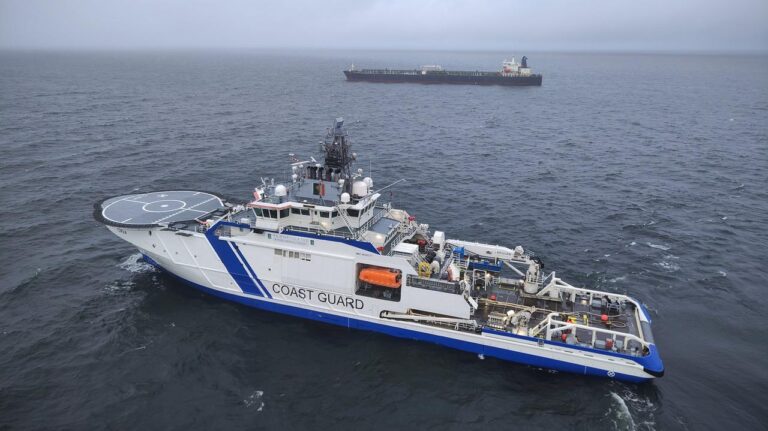The operation to move the tanker Eagle S, which is suspected of damaging the underground power line EstLink2, to the port of Porvoo went according to plan, the Finnish police said.
The tanker, accompanied by several patrol boats, a tugboat and a border patrol helicopter, moved east towards Porvoo oil port. Police believe the vessel will remain anchored in a local bay for an extended period of time for investigation.
Tanker Eagle SFINNISH Border BUARD/PAP/EPA was arrested in Finland
The tanker was arrested
Previously, the tank was detained in the open waters of the Gulf of Finland, near the Porkkala peninsula, west of Helsinki.
The Eagle S, believed to belong to Russia’s shadow fleet, was detained on Wednesday after a failure to transmit power through EstLink 2 was discovered. The Customs Service is also investigating sanctions violations in connection with cargo transported by tanker – about 35,000 tons of gasoline from Russia.
Quick and decisive action prevented further damage. Heikki Porola of Helsinki police told Finland’s STT news agency that the ship was heading west towards another energy transmission line, EstLink 1, and the Balticconnector gas pipeline. At the time of the ship’s arrest, the service reported, the ship’s anchor was “not in place.” It is emphasized that the coiled chain itself, which weighs thousands of kilograms, can damage other structures under the sea.
– Finnish authorities have reacted decisively after previous incidents involving cable damage, refusing to allow the suspicious ship to leave the Gulf of Finland and ending the cat-and-mouse game, said Mika Aaltola, former head of the Finnish Institute of International Relations. and currently a Member of Parliament.
Read more: Detained Eagle S tanker ‘loaded with spy equipment’ >>>
Finnish Coast Guard on Tanker Eagle SPAP/EPA/HANDOUT
Risks ‘inevitably increasing’
According to him, if NATO increases its presence in the Gulf of Finland, as planned, and Russia responds by using its fleet to protect transport routes, “the risk of collision between warships will definitely increase.” Although the Baltic Sea has become NATO’s internal sea, Russia wants to “show its presence and test the reactions of the West,” Aaltola added.
Member of parliament and cyber security expert, prof. Jarno Limnel warned against “Russian provocations” because the Baltic Sea is a special oil transportation corridor for Russia. The expert also drew attention to other areas such as the Åland Islands and the Königsberg region.
In turn, according to the chairman of the defense committee of the parliament, Jukka Kopra, only now, after the damage to EstLink 2 and the arrest of the suspicious ship, “the search for ways to fight the shadow fleet” will begin.
Main photo source: FINLANDSH BORDER BOARD/PAP/EPA

